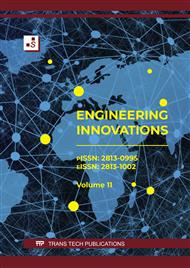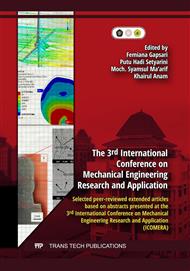[1]
D. A. Musyaffa, Moch. A. Choiron, Y. S. Irawan, N. A. Hidayati, T. Taryono, and S. Gorbatyuk, "COMPUTER SIMULATION INVESTIGATION OF CRASH BOX DESIGN AS SAFETY-PROTECTION TECHNOLOGY FOR INDONESIA HIGH SPEED TRAIN," International Journal of Mechanical Engineering Technologies and Applications, vol. 4, no. 1, p.97–103, Jan. 2023.
DOI: 10.21776/MECHTA.2023.004.01.11
Google Scholar
[2]
W. Hardi, Analisis elemen hingga untuk uji tabrakan mobil dengan ansys ls dyna. Bandung: Media Sains Indonesia, 2022.
Google Scholar
[3]
R. B. Shinde and K. D. Mali, "An Overview on Impact Behaviour and Energy Absorption of Collapsible Metallic and Non-Metallic Energy Absorbers used in Automotive Applications," IOP Conf Ser Mater Sci Eng, vol. 346, no. 1, 2018.
DOI: 10.1088/1757-899X/346/1/012054
Google Scholar
[4]
W. J. Witteman, Improved Vehicle Crashworthiness Design by Control of the Energy Absorption for Different Collision Situations. 1999.
Google Scholar
[5]
J. Bouchet, E. Jacquelin, and P. Hamelin, "Static and dynamic behavior of combined composite aluminum tube for automotive applications," Compos Sci Technol, vol. 60, no. 10, p.1891–1900, 2000.
DOI: 10.1016/S0266-3538(00)00058-0
Google Scholar
[6]
H. R. Zarei and M. Kröger, "Crashworthiness optimization of empty and filled aluminum crash boxes," International Journal of Crashworthiness, vol. 12, no. 3, p.255–264, 2007.
DOI: 10.1080/13588260701441159
Google Scholar
[7]
Guoxing Lu and Tongxi Yu, Energy absorption of structures and materials. Cambridge: CRC Press LLC, 2003.
Google Scholar
[8]
N. Jones, Structural Impact. Cambridge, 1989.
Google Scholar
[9]
D. Al Galib and A. Limam, "Experimental and numerical investigation of static and dynamic axial crushing of circular aluminum tubes," Thin-Walled Structures, vol. 42, no. 8, p.1103–1137, 2004.
DOI: 10.1016/j.tws.2004.03.001
Google Scholar
[10]
W. Hardi, "IOP Conference Series : Materials Science and Engineering The behavior of various thin-walled aluminum prisms subjected by axial impact loading in relation to the energy absorption abilities," in Tarumanagara International Conference on Appalications of Technology and Engineering, Jakarta: IOP Publishing, 2018, p.11.
DOI: 10.1088/1757-899x/508/1/012066
Google Scholar
[11]
F. Mat, K. A. Ismail, S. Yaacob, and O. Inayatullah, "Impact response of thin-walled tubes: A prospective review," Applied Mechanics and Materials, vol. 165, no. March 2014, p.130–134, 2012.
DOI: 10.4028/www.scientific.net/AMM.165.130
Google Scholar
[12]
Z. G. Wei, J. L. Yu, and R. C. Batra, "Dynamic buckling of thin cylindrical shells under axial impact," Int J Impact Eng, vol. 32, no. 1–4, p.575–592, 2006.
DOI: 10.1016/j.ijimpeng.2005.07.008
Google Scholar
[13]
A. Ghamarian and M. Tahaye Abadi, "Axial crushing analysis of end-capped circular tubes," Thin-Walled Structures, vol. 49, no. 6, p.743–752, 2011.
DOI: 10.1016/j.tws.2011.01.006
Google Scholar
[14]
A. A. A. Alghamdi, "Collapsible impact energy absorbers: An overview," Thin-Walled Structures, vol. 39, no. 2, p.189–213, 2001.
DOI: 10.1016/S0263-8231(00)00048-3
Google Scholar
[15]
W. Hardi, "The effect of impact velocity to the reaction force, the deformation length and the deformation mode on a thin aluminum tube," J Phys Conf Ser, vol. 1569, no. 4, 2020.
DOI: 10.1088/1742-6596/1569/4/042088
Google Scholar
[16]
M. Higuchi, Y. Hamaguchi, S. Suzuki, and T. Adachi, "Dynamic Behavior of a Circular Tube Subjected to High Impact Loading," 6th International Symposium on Advanced Science and Technology in Experimental Mechanics, p.3–5, 2011.
Google Scholar
[17]
M. A. Choiron, A. Purnowidodo, E. Siswanto, and N. A. Hidayati, "Crash energy absorption of multi-segments crash box under frontal load," 2016.
DOI: 10.11113/jt.v78.8334
Google Scholar
[18]
M. Rismanto, Moch. A. Choiron, and S. Sugiono, "Optimasi Parameter Desain Multi-Cell Hexagonal Crash Box terhadap Absorbsi Energy Impact dengan Metode Taguchi," Jurnal Rekayasa Mesin, vol. 11, no. 3, p.427–440, Dec. 2020, doi: 10.21776/UB.JRM. 2020.011.03.15.
DOI: 10.21776/ub.jrm.2020.011.03.15
Google Scholar
[19]
M. A. Choiron, M. A. Yaqin, and A. Yaqin, "Optimization of two segments crash box with rubber joint using response surface methodology ARTICLES YOU MAY BE INTERESTED IN Optimization of Two Segments Crash Box with Rubber Joint Using Response Surface Methodology," vol. 2278, p.20012, 2020.
DOI: 10.1063/5.0014583
Google Scholar
[20]
"View of Energy Absorption and Deformation Pattern on Two Segment Crash Box with Rubber Connection Variation." Accessed: Mar. 06, 2023. [Online]. Available: https://akademiabaru.com/submit/index.php/arfmts/article/view/2454/1413
Google Scholar
[21]
K. Günaydın, O. Gülcan, and H. S. Türkmen, "Experimental and numerical crushing performance of crash boxes filled with re-entrant and anti-tetrachiral auxetic structures," International Journal of Crashworthiness, vol. 28, no. 5, p.649–663, 2023.
DOI: 10.1080/13588265.2022.2115962
Google Scholar
[22]
Q. Gao, G. Yin, C. C. L. Wang, and W. H. Liao, "Crushing and theoretical analysis of multi-cell tube filled with auxetic structure under axial impact loading," Mechanics of Advanced Materials and Structures, vol. 30, no. 24, p.5034–5046, 2023, doi:10.1080/15376494. 2022.2111730.
DOI: 10.1080/15376494.2022.2111730
Google Scholar
[23]
P. K. A and A. K. G, "Effect of the number of stiffeners on the lateral deformation behavior of additively manufactured thin-walled cylindrical tubes," Mechanics of Advanced Materials and Structures, 2023.
DOI: 10.1080/15376494.2023.2172235
Google Scholar
[24]
T. Adachi, A. Tomiyama, W. Araki, and A. Yamaji, "Energy absorption of a thin-walled cylinder with ribs subjected to axial impact," Int J Impact Eng, vol. 35, no. 2, p.65–79, 2008.
DOI: 10.1016/j.ijimpeng.2006.11.005
Google Scholar
[25]
Z. Ahmad, "Impact and Energy Absorption of Empty and Foam-filled Conical Tubes," Proceedings of COBEM, no. December, 2009.
Google Scholar



